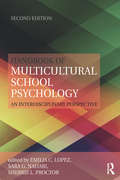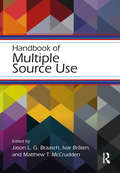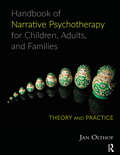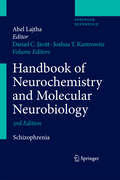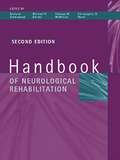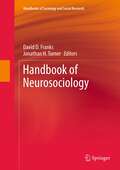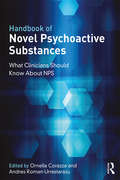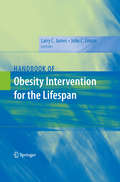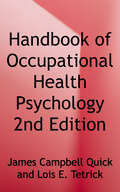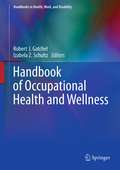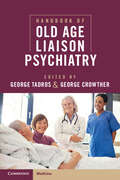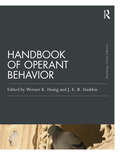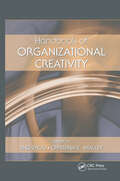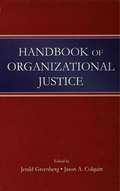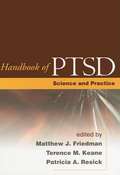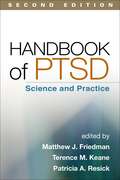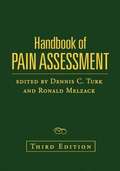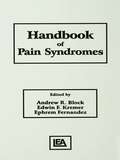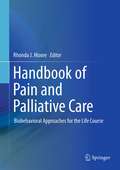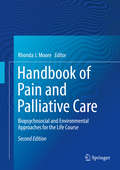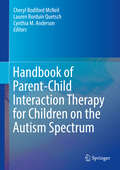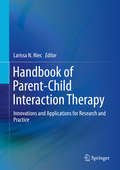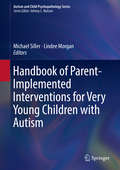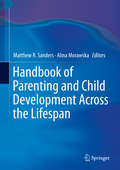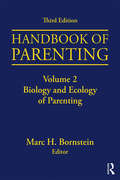- Table View
- List View
Handbook of Multicultural School Psychology: An Interdisciplinary Perspective (Consultation, Supervision, and Professional Learning in School Psychology Series)
by Emilia C. Lopez Sara G. Nahari Sherrie L. ProctorThe second edition of the Handbook of Multicultural School Psychology continues the mission of its predecessor, offering a comprehensive, interdisciplinary view of the field of multicultural school psychology and addressing the needs of children and families from diverse cultural backgrounds. The revised organizational structure includes the following: History and Professional Issues; Consultation and Collaboration; Interventions Focused on Academic and Mental Health Issues; Data-based Decision Making; Systems-based Issues; Training and Research; and Future Perspectives. Nineteen of the volume's twenty-three chapters are completely new to this edition, while the rest have been effectively revised and updated. Comprehensive—In seven sections, this book covers theoretical, research, and practical concerns in a wide range of areas that include multicultural and bilingual issues, second language acquisition, acculturation, parent collaboration, research, and systemic issues. Chapter Structure—Chapter authors follow a uniform structure that includes theoretical and research issues and implications for practice. Recent practice and training guidelines including Blueprint for Training and Practice III (2006), NASP Model for Comprehensive and Integrated School Psychological Services (2010), and APA Multicultural Guidelines (2003) are covered. Interdisciplinary Perspective—Contributing authors are from a wide range of related fields that include school psychology, special education, general education, early childhood education, educational psychology, clinical psychology, counseling, and mental health, thus exposing readers to theory and research from various approaches. Changes—New to this edition is a section focusing on systemic issues such as overrepresentation of culturally and linguistically diverse (CLD) students in special education, prejudice, response to intervention (RTI) for CLD students and English Language Learners (ELL), and end-of-chapter discussion questions. This book is ideal for graduate courses and seminars on multicultural school psychology. It is also a useful reference for researchers and practicing school psychologists and the libraries that serve them.
Handbook of Multiple Source Use (Educational Psychology Handbook)
by Jason L.G. Braasch Matthew T. McCrudden Ivar BråtenThe Handbook of Multiple Source Use draws on theory and research within cognitive and educational psychology, the learning sciences, disciplinary education, information literacy, reading psychology, and social psychology, to present the first comprehensive research volume on this topic. Many learners both in and out of school have almost instantaneous access to an enormous range of information sources at present. In this book, broken into six sections, international scholars come together toward understanding factors that influence how individuals cope with the challenge of building knowledge from diverse, often conflicting, information.
Handbook of Narrative Psychotherapy for Children, Adults, and Families: Theory and Practice
by Jan OlthofThe Handbook Narrative Psychotherapy for Children, Adults and Families combines philosophical, scientific and theoretical insights in the field of narrative psychotherapy and links them to sources of inspiration such as poetry, film, literature and art under the common denominator 'narrative thinking'. Sections on theoretical issues alternate with a large number of case histories drawn from different therapeutic contexts. The reader can browse at will through the many examples of therapeutic sessions, in some cases including literal transcriptions, in which narrativity in all its forms is the point of departure. What language does the body speak? What messages do seemingly random slips of the tongue convey? How can a painting help a client to find words for his or her story? The discussion of the 'logic of abduction' demonstrates the importance of metaphor, and special attention is given to the processes of creating a therapeutic context and defining a therapeutic framework.
Handbook of Neurochemistry and Molecular Neurobiology
by Abel Lajtha Joshua Kantrowitz Daniel C. JavittThis volume of the Handbook of Neurochemistry and Molecular Neurobiology focuses on neurochemical aspects of schizophrenia. Chapters cover the full range of schizophrenia symptoms and anatomical pathologies from neurochemical and molecular biology perspectives. Topics include changes in neurotransmitter systems, alteration in receptors, neurotransmitter release, genetic factors, protein alterations, and redox dysregulation.
Handbook of Neurological Rehabilitation
by Christopher D. Ward Richard J. Greenwood Michael P. Barnes Thomas M. McMillanChanges in the focus of neurological practice worldwide have led to the need for new standard texts that reflect the current state of this expanding area of clinical expertise. The second edition of the Handbook of Neurological Rehabilitation is a major reference source that fulfils this need, providing an invaluable resource for all professions that work with patients suffering from neurological disorders. It brings restorative neurology to the bedside and shows how a reiterative, goal-oriented, problem-solving training programme can benefit patients, sometimes on a scale not achieved by pharmacological or surgical interventions.The book is divided into three sections all of which have been updated. Section One explores the clinical and biological principles underpinning rehabilitation practice in the context of neurological disablement. Section Two describes the assessment, treatment, and management of the major physical, cognitive and behavioural impairments, and the resulting functional deficits that may follow or accompany neurological disease. The final section explores in more detail these problems and their management in relation to the more common specific disorders of the nervous system.The text emphasises the fact that rehabilitation is an ongoing process involving multidisciplinary problem-solving, goal-setting and education; in which organised care is more effective than unorganised care; and the breakdown of professional barriers within rehabilitation, to facilitate the use of combined treatment techniques, improves outcome. It describes the contribution made by neural reorganisation and compensatory mechanisms to recovery of function, focuses on the avoidance of secondary deficit, and explores the physical, cognitive, affective and behavioural problems that may occur after neurological damage.At a time when new medical technologies threaten to fragment the integrity of medical care at individual and societal levels, it is crucial that all those involved in the management of chronic neurological disease have a working knowledge of the contents of this book. Their perspective on clinical practice will then be truly integrated and holistic and their patients will benefit accordingly.
Handbook of Neurosociology
by Jonathan H. Turner David D. FranksUntil recently, a handbook on neurosociology would have been viewed with skepticism by sociologists, who have long been protective of their disciplinary domain against perceived encroachment by biology. But a number of developments in the last decade or so have made sociologists more receptive to biological factors in sociology and social psychology. Much of this has been encouraged by the coeditors of this volume, David Franks and Jonathan Turner. This new interest has been increased by the explosion of research in neuroscience on brain functioning and brain-environment interaction (via new MRI technologies), with implications for social and psychological functioning. This handbook emphasizes the integration of perspectives within sociology as well as between fields in social neuroscience. For example, Franks represents a social constructionist position following from G.H. Mead's voluntaristic theory of the act while Turner is more social structural and positivistic. Furthermore, this handbook not only contains contributions from sociologists, but leading figures from the psychological perspective of social neuroscience.
Handbook of Novel Psychoactive Substances: What Clinicians Should Know about NPS
by Ornella Corazza Andres Roman-UrrestarazuHandbook of Novel Psychoactive Substances (NPS) provides a comprehensive overview of the challenges that clinicians face when dealing with NPS and discusses how the profile of patients and their socio-demographic characteristics frame the serious public health concern that NPS pose. It presents various clinical cases, as well as detailed accounts of symptoms, psychopathology, toxicity, and overall clinical management that NPS require. This handbook brings together a unique collection of chapters written by leading experts in the field, who have felt the need to share their knowledge and experience to improve the clinical practice on NPS and the wellbeing of their patients.
Handbook of Obesity Intervention for the Lifespan
by Larry James John C. LintonEnvironmental, genetic, psychological, and societal factors interact to produce obesity, a chronic condition of epidemic proportions. The Handbook of Obesity Intervention for the Lifespan guides professionals in meeting this complex challenge with a multidisciplinary palette of evidence-based interventions that can be tailored to men and women across the lifespan, regardless of background. This unique reference combines salient research data and hands-on clinical applications for use with overweight patients, from the very young to the very old, and includes a "treatment resources" section with extra materials to bolster therapy--all geared toward respectful, encouraging treatment and lasting weight-loss results.
Handbook of Occupational Health Psychology
by James C. Quick Lois E. TetrickIn today's difficult global economy, work stress is high, and this stress--along with other health factors--can affect work productivity, satisfaction, safety, absenteeism, turnover, and even workplace violence. As a result, organizations are increasingly turning to occupational health psychology (OHP) to develop, maintain, and promote the health of employees. <p><p>This second edition of the Handbook of Occupational Health Psychology reviews the history of OHP; theories and models; causes of work problems and risks; resulting symptoms and disorders; prevention, intervention, and treatment strategies used by practicing professionals; and methods of research and evaluation. The chapters have been updated since the first edition was published, and several new chapters have been added addressing cross-cultural issues, leadership, pain and musculoskeletal conditions, substance abuse, and organizational justice. <p><p>With a comprehensive scope and interdisciplinary approach, this book will interest professionals from a range of specialties, including industrial and organizational psychology, human factors, social psychology, health psychology, clinical psychology, public health, preventive medicine, and industrial engineering.
Handbook of Occupational Health and Wellness
by Izabela Z. Schultz Robert J. GatchelThis book integrates the growing clinical research evidence related to the emerging transdisciplinary field of occupational health and wellness. It includes a wide range of important topics, ranging from current conceptual approaches to health and wellness in the workplace, to common problems in the workplace such as presenteeism/abstenteeism, common illnesses, job-related burnout, to prevention and intervention methods. It consists of five major parts. Part I, "Introduction and Overviews," provides an overview and critical evaluation of the emerging conceptual models that are currently driving the clinical research and practices in the field. This serves as the initial platform to help better understand the subsequent topics to be discussed. Part II, "Major Occupational Symptoms and Disorders," exposes the reader to the types of critical occupational health risks that have been well documented, as well as the financial and productivity losses associated with them. In Part III, "Evaluation of Occupational Causes and Risks to Workers' Health," a comprehensive evaluation of these risks and causes of such occupational health threats is provided. This leads to Part IV, "Prevention and Intervention Methods," which delineates methods to prevent or intervene with these potential occupational health issues. Part V, "Research, Evaluation, Diversity and Practice," concludes the book with the review of epidemiological, measurement, diversity, policy, and practice issues-with guidelines on changes that are needed to decrease the economic and health care impact of illnesses in the workplace, and recommendations for future. All chapters provide a balance among theoretical models, current best-practice guidelines, and evidence-based documentation of such models and guidelines. The contributors were carefully selected for their unique knowledge, as well as their ability to meaningfully present this information in a comprehensive manner. As such, this Handbook is of great interest and use to health care and rehabilitation professionals, management and human resource personnel, researchers and academicians alike.
Handbook of Old Age Liaison Psychiatry
by George Tadros George CrowtherThis essential new handbook provides practical and essential information on old age liaison psychiatry in the general hospital setting, for use in everyday practice. Covering the assessment and management of older people's mental health, it addresses the most common day-to-day clinical presentations and conditions. The book provides a unique and valuable insight into the emotional and psychological challenges that older people and their families face in hospital, when dealing with both physical health and social crises. Featuring contributions from a range of experts from diverse medical and psychiatric specialities on topics such as service development, use of technology, ethical issues, safeguarding procedures and evidence-based practice for effective management. The book shines a light on the integration of mental and physical health for older people and the importance of managing all aspects of care, alongside the impact of each on mental health. An essential guide for hospital clinicians across all specialties.
Handbook of Operant Behavior (Psychology Press & Routledge Classic Editions)
by Werner K. Honig J. E. R. StaddonThis classic edition of the Handbook of Operant Behavior presents seminal work in the field of learning and behavior, foreshadowing a new direction for learning research, and presenting many questions that remain unanswered. Featuring impressive contributions from leading figures across the field—ranging from N. J. Mackintosh from what was to become the cognitive school through Morse, Kelleher, Hutchinson, and Hineline on the neglected topic of aversive control to Blough and Blough on psychophysics to Philip Teitelbaum on behavioral physiology—the book is a must-read for anyone interested in human and animal learning. In a newly written introduction, J. E. R. Staddon highlights several issues that deserve more attention: how language is learned and syntax evolves, how animals choose, and a new paradigm for the study of learning in general. The book is essential reading for all students and researchers of learning and behavior, and aims to encourage researchers to revisit some of the fascinating behavioral questions raised by the original book.
Handbook of Organizational Creativity
by Jing Zhou Christina E. ShalleyThis volume is a comprehensive and cutting-edge reference book reflecting current knowledge in the rapidly growing area of organizational creativity. The contributors to this volume are all leading researchers in the field of organizational creativity. This volume: provides a historical review of organizational creativity theory and research presents critical reviews and summaries of research on micro, meso, and macro topics (e.g., leadership, feedback, goals and role expectations, groups and teams, social networks, climate and culture, deep structures, sense-making processes, and creativity and organizational change) concerning organizational creativity demonstrates contributions of creativity to individual work outcomes and organizational success discusses emerging areas and highlights promising future research trends. Professors and graduate students in management and psychology will find this volume most beneficial. Professors and graduate students in marketing, sociology, and education also may find this book useful and relevant. Thoughtful managers and executives, professionals and knowledge workers, and aspiring managers and MBA students also would find this book beneficial in sharpening their thinking, and helping them to identify the right tools for managing creativity.
Handbook of Organizational Justice
by Jason A. Colquitt Jerald GreenbergMatters of perceived fairness and justice run deep in the workplace. Workers are concerned about being treated fairly by their supervisors; managers generally are interested in treating their direct reports fairly; and everyone is concerned about what happens when these expectations are violated. This exciting new handbook covers the topic of organizational justice, defined as people's perceptions of fairness in organizations.The Handbook of Organizational Justice is designed to be a complete, current, and comprehensive reference chronicling the current state of the organizational justice literature. Tracing the development of ideas regarding organizational justice, this book:*introduces the topic of organizational justice from a historical perspective and presents fundamental issues regarding the nature of organizational justice;*examines the justice judgment process, specifically addressing basic psychological processes, such as the roles of control, self-interest, morality, and trust in the formation of justice judgments;*discusses the consequences of fair and unfair treatment in the workplace;*focuses on such key issues as promoting justice in the workplace in ways that help manage stress, and the underlying processes that account for the effectiveness of justice applications;*examines the generalizability of the interaction between process and outcomes and focuses on the notion of cross-cultural differences in justice effects; and*summarizes the state of the science of organizational justice and presents various issues for future research and theorizing.This Handbook is useful as a guide for professors and graduate students, primarily in the fields of management and psychology. It also is highly relevant to professionals in the fields of communication, sociology, legal studies, marketing, and human resources management.
Handbook of PTSD
by Terence Keane Matthew FriedmanUnparalleled in its breadth and depth, this state-of-the-art handbook reviews current scientific advances in understanding trauma and PTSD, discusses the implications for clinical practice, and evaluates the status of evidence-based assessment and treatment. The foremost authorities in the field examine posttraumatic psychological reactions on multiple levels, from genes and neurocircuitry to gender and lifespan development. Established and emerging psychological, medical, and public health interventions are discussed in depth, as are issues in tailoring treatment to the needs of different populations. Special topics include forensic issues, resilience, and prevention. The integrative concluding chapter presents a reasoned agenda for future research.
Handbook of PTSD, Second Edition: Science and Practice
by Matthew J. Friedman Patricia A. Resick Terence M. KeaneWidely regarded as the definitive reference, this handbook brings together foremost authorities on posttraumatic stress disorder (PTSD). Diagnostic, conceptual, and treatment issues are reviewed in depth. The volume examines the causes and mechanisms of PTSD on multiple levels, from psychological processes to genes and neurobiology. Risk and resilience processes are addressed across development and in specific populations. Contributors describe evidence-based assessment and treatment approaches as well as promising emerging interventions. The integrative concluding chapter identifies key unanswered questions with important implications for science and practice. New to This Edition *Reflects major research advances and the new diagnostic criteria in DSM-5. *Chapters on the dissociative subtype of PTSD, child assessment, couple and family therapies, and group treatments. *Chapters on research methods, Internet-based interventions, telemental health, and implementation of best practices. *Many new authors and extensively revised chapters.
Handbook of Pain Assessment, Third Edition
by Ronald Melzack Dennis TurkThis definitive clinical reference comprehensively reviews the most advanced methods for assessing the person in pain. The field's leading authorities present essential information and tools for evaluating psychosocial, behavioral, situational, and medical factors in patients' subjective experience, functional impairment, and response to treatment. Empirically supported instruments and procedures are detailed, including self-report measures, observational techniques, psychophysiological measures, and more. Best-practice recommendations are provided for assessing the most prevalent pain syndromes and for working with children, older adults, and people with communication difficulties. The book also weighs in on the limitations of existing methods and identifies key directions for future research. New to This Edition Concise chapters and a heightened focus on practical clinical issues. *Incorporates significant advances in knowledge about pain and pain syndromes. Numerous new or refined assessment instruments and procedures, including applications of advanced imaging techniques. Chapter providing an integrated, comprehensive assessment approach for any type of chronic pain.
Handbook of Pain Syndromes: Biopsychosocial Perspectives
by Andrew R. Block Edwin F. Kremer Ephrem FernandezPain syndromes involve a complex interaction of medical and psychological factors. In each syndrome unique physiological mechanisms are mediated by emotional states, personality traits, and environmental pressures to determine the nature and extent of pain complaints and pain-related disability. The Handbook addresses the complexities of chronic pain in three ways. Section I describes general concerns that cross-cut the different syndromes, such as the use of narcotic pain medications, the detection of deception and malingering, and the epidemiology of pain. Section II presents comprehensive reviews of a wide range of pain syndromes. Each covers basic pathophysiology, psychological factors found to influence the course of the syndrome, and syndrome-specific multidisciplinary treatment approaches. Most of the Section II chapters are coauthored by psychologists and physicians. Section III discusses pain in special populations, including the elderly and children. The Handbook is the most up-to-date, comprehensive, and integrated single-volume resource for all those professionally concerned with pain.
Handbook of Pain and Palliative Care
by Rhonda J. MooreHandbook of Pain and Palliative Care:Biobehavioral Approaches for the Life Course Rhonda J. Moore, editor This book takes both a biobehavioral and a lifespan approach to understanding long-term and chronic pain, and intervening to optimize patients' functioning. Rich in clinical diversity, chapters explore emerging areas of interest (computer-based interventions, fibromyalgia, stress), ongoing concerns (cancer pain, low back pain), and special populations (pediatric, elderly, military). This coverage provides readers with a knowledge base in assessment, treatment, and management that is up to date, practice strengthening, and forward looking. Subject areas featured in the Handbook include: Patient-practitioner communication Assessment tools and strategies Common pain conditions across the lifespan Biobehavioral mechanisms of chronic pain Pharmaceutical, neurological, and rehabilitative interventions Psychosocial, complementary/alternative, narrative, and spiritual approaches Ethical issue and future directions With the rise of integrative perspective and the emphasis on overall quality of life rather than discrete symptoms, pain management is gaining importance across medical disciplines. Handbook of Pain and Palliative Care stands out as a one-stop reference for a range of professionals, including health practitioners specializing in pain management or palliative care, clinical and health psychologists, public health professionals, and clinicians and administrators in long-term care and hospice.usculoskeletal pain. Finally, the text discusses broader issues in chronic pain management, including psychosocial issues associated with chronic pain, spiritual dimensions of chronic pain and suffering, contributions from the humanities and social sciences in terms of understanding the chronic pain experience, and highlights ethical issues in pain and palliative care. The collaborators for this project are from diverse cultural and biomedical settings, including the United Kingdom, United States, Italy, England, Singapore, Canada, Australia, and Norway. The expertise in this volume span the fields of clinical medicine, neuroscience, neurosurgery, literature, anthropology, art, neuroanatomy, pediatrics, gerontology, pain imaging, health disparities, transportation, rehabilitation, palliative medicine, philanthropy, the medical humanities, oncology, physiology, anesthesiology, pharmacology, genetics, stress management, psychology, dentistry, complementary and alternative medicine, spiritual care, nursing, pain policy, and clinical ethics. Whilst highly multidisciplinary, authors explore the evidence base for chronic pain and palliative care in their individual professional areas and each has provided valuable insights with the hope that it will result in improved pain control and palliative care.
Handbook of Pain and Palliative Care: Biopsychosocial and Environmental Approaches for the Life Course
by Rhonda J. MooreThis comprehensive revision of the invaluable reference presents a rigorous survey of pain and palliative care phenomena across the lifespan and across disciplines. Grounded in the biopsychosocial viewpoint of its predecessor, it offers up-to-date understanding of assessments and interventions for pain, the communication of pain, common pain conditions and their mechanisms, and research and policy issues. In keeping with the current public attention to painkiller use and misuse, contributors discuss a full range of pharmacological and non-pharmacological approaches to pain relief and management. And palliative care is given expanded coverage, with chapters on interventive, ethical, and spiritual concerns.· Pain, intercultural communication, and narrative medicine.· Assessment of pain: tools, challenges, and special populations.· Persistent pain in the older adult: practical considerations for evaluation and management.· Acute to chronic pain: transition in the post-surgical patient. · Evidence-based pharmacotherapy of chronic pain.· Complementary and integrative health in chronic pain and palliative care.· The patient’s perspective of chronic pain.· Disparities in pain and pain care.This mix of evolving and emerging topics makes the Second Edition of the Handbook of Pain and Palliative Care a necessity for health practitioners specializing in pain management or palliative care, clinical and health psychologists, public health professionals, and clinicians and administrators in long-term care and hospice.
Handbook of Parent-Child Interaction Therapy for Children on the Autism Spectrum
by Cynthia M. Anderson Cheryl Bodiford McNeil Lauren Borduin QuetschThis handbook offers a theoretical foundation for the adaptation of Parent-Child Interaction Therapy (PCIT) for children with autism spectrum disorder (ASD) and their families. The volume examines current treatments for children with ASD and provides a rationale for why PCIT is considered a strong option to address many of the concerns found within this population of children and families. It presents an overview of PCIT theory, the goals of PCIT, the unique aspects of the treatment, and the exceptional outcomes. The handbook demonstrates the versatility of PCIT in conjunction with standard science-based therapies in addressing specific behavioral problems in this young population. Chapters provide a theoretical basis for PCIT, the empirical evidence for its efficacy, clinical considerations, and training issues. Chapters also offer a selection of case studies that help illustrate how PCIT has been successful in treating children with autism. The handbook concludes by identifying the gaps that need to be addressed by future research. Topics featured in the Handbook include:A clinical description of Parent-Child Interaction Therapy. The effects of medication for individuals with ASD.The importance of parent-child interactions in social communication and development.Teaching complex social behavior to children with ASD.Internet-delivered PCIT (I-PCIT) for children with autism.Child-Directed Interaction treatments for children with ASD.Parent-Directed Interaction treatments for children on the autism spectrum. The Handbook of Parent-Child Interaction Therapy for Children on the Autism Spectrum is a must-have resource for researchers, professors, clinicians/practitioners/therapists, and graduate students across many interrelated disciplines, including child and school psychology, behavioral therapy, social work, child and adolescent psychiatry, pediatrics, and family studies as well as occupational therapy, physical therapy, behavior analysis, and speech therapy.
Handbook of Parent-Child Interaction Therapy: Innovations and Applications for Research and Practice
by Larissa N. NiecThis handbook examines advances in the evidence-based behavioral family intervention, parent-child interaction therapy (PCIT). It surveys innovative adaptations tailored to specific diagnostic concerns, client populations, treatment settings, and delivery formats. Chapters provide rationales for adaptation, reviews of relevant research, and discussions of advantages and challenges. Case studies illustrate the implementation of the adaptations and help to make new techniques concrete. The handbook offers practical descriptions of the adaptations to PCIT, comprehensively reviews treatment outcome literature, and integrates cutting-edge implementation science into an exploration of the current dissemination strategies in PCIT. The handbook concludes with a consideration of the questions that remain to be addressed to extend the reach of PCIT among traditionally underserved families and to continue to advance the science and practice of children’s mental health interventions. Featured topics include:PCIT for children with callous-unemotional traits.PCIT for families with a history of child maltreatment.Group PCIT.PCIT for military families.The PCIT CALM program for treating anxiety in young children.PCIT for American Indian families.Transporting and disseminating PCIT internationally.Using technology to expand the reach of PCIT. The Handbook of Parent-Child Interaction Therapy is a must-have resource for researchers, professors, instructors, clinicians, and graduate students in child and school psychology, child psychiatry, and social work as well as such related disciplines as developmental, clinical, counseling, and community psychology, family studies, and mental health services and agencies.
Handbook of Parent-Implemented Interventions for Very Young Children with Autism (Autism and Child Psychopathology Series)
by Michael Siller Lindee MorganThis handbook offers practical strategies and evidence-based parent-implemented interventions for very young children with autism spectrum disorder (ASD). It explores this important subject within the context of rapidly increasing numbers of toddlers who are diagnosed with ASD during the second year of life. The handbook discusses how parents of young children with ASD can effectively be supported, taught, and coached to implement evidence-based parenting strategies and intervention techniques, and describes a broad range of developmentally appropriate programs at the family, community, and service delivery levels. In addition, the handbook examines individual differences in parenting cognitions, emotions, and practices and proposes strategies for supporting the varying capacities of diverse families to meet the needs of young children with ASD. Chapters provide diverse coverage, spanning cultural/socio-economic differences as well as differences in family structure; parenting cognitions, emotions, and practices; parental learning styles; and access to social support. Featured topics include: Supporting families of high-risk infants who have an older sibling with ASD.The use of video feedback strategies in parent-mediated early ASD intervention. The Incredible Years (IY) Parent Program for preschool children with ASD and language delays. Self-help for parents of children with ASD. The Family Implemented TEACCH for Toddlers (FITT) support model. Parent-implemented interventions for underserved families in Taiwan. Family and provider-based interventions in South Asia. The Handbook of Parent-Implemented Interventions for Very Young Children with Autism is a must-have resource for researchers, clinicians/professionals, and graduate students in clinical child, school, and developmental psychology, family studies, behavioral therapy, and social work as well as rehabilitation medicine/therapy, child and adolescent psychiatry, pediatrics, and special education/educational psychology.
Handbook of Parenting and Child Development Across the Lifespan
by Matthew R. Sanders Alina MorawskaThis handbook presents the latest theories and findings on parenting, from the evolving roles and tasks of childrearing to insights from neuroscience, prevention science, and genetics. Chapters explore the various processes through which parents influence the lives of their children, as well as the effects of parenting on specific areas of child development, such as language, communication, cognition, emotion, sibling and peer relationships, schooling, and health. Chapters also explore the determinants of parenting, including consideration of biological factors, parental self-regulation and mental health, cultural and religious factors, and stressful and complex social conditions such as poverty, work-related separation, and divorce. In addition, the handbook provides evidence supporting the implementation of parenting programs such as prevention/early intervention and treatments for established issues. The handbook addresses the complementary role of universal and targeted parenting programs, the economic benefits of investment in parenting programs, and concludes with future directions for research and practice. Topics featured in the Handbook include: · The role of fathers in supporting children’s development. · Developmental disabilities and their effect on parenting and child development. · Child characteristics and their reciprocal effects on parenting. · Long-distance parenting and its impact on families. · The shifting dynamic of parenting and adult-child relationships. · The effects of trauma, such as natural disasters, war exposure, and forced displacement on parenting. The Handbook of Parenting and Child Development Across the Lifespan is an essential reference for researchers, graduate students, clinicians, and therapists and professionals in clinical child and school psychology, social work, pediatrics, developmental psychology, family studies, child and adolescent psychiatry, and special education.
Handbook of Parenting: Volume 2: Biology and Ecology of Parenting, Third Edition
by Marc H. BornsteinThis highly anticipated third edition of the Handbook of Parenting brings together an array of field-leading experts who have worked in different ways toward understanding the many diverse aspects of parenting. Contributors to the Handbook look to the most recent research and thinking to shed light on topics every parent, professional, and policymaker wonders about. Parenting is a perennially "hot" topic. After all, everyone who has ever lived has been parented, and the vast majority of people become parents themselves. No wonder bookstores house shelves of "how-to" parenting books, and magazine racks in pharmacies and airports overflow with periodicals that feature parenting advice. However, almost none of these is evidence-based. The Handbook of Parenting is. Period. Each chapter has been written to be read and absorbed in a single sitting, and includes historical considerations of the topic, a discussion of central issues and theory, a review of classical and modern research, and forecasts of future directions of theory and research. Together, the five volumes in the Handbook cover Children and Parenting, the Biology and Ecology of Parenting, Being and Becoming a Parent, Social Conditions and Applied Parenting, and the Practice of Parenting. Volume 2, Biology and Ecology of Parenting, relates parenting to its biological roots and sets parenting in its ecological framework. Some aspects of parenting are influenced by the organic makeup of human beings, and the chapters in Part I, on the Biology of Parenting, examine the evolution of parenting, the psychobiological determinants of parenting in nonhumans, and primate parenting, as well as the genetic, prenatal, neuroendocrinological, and neurobiological bases of human parenting. A deep understanding of what it means to parent also depends on the ecologies in which parenting takes place. Beyond the nuclear family, parents are embedded in, influence, and are themselves affected by larger social systems. The chapters in Part II, on the Ecology of Parenting, examine the ancient and modern histories of parenting as well as epidemiology, neighborhoods, educational attainment, socioeconomic status, culture, and environment to provide an overarching relational developmental contextual systems perspective on parenting.
